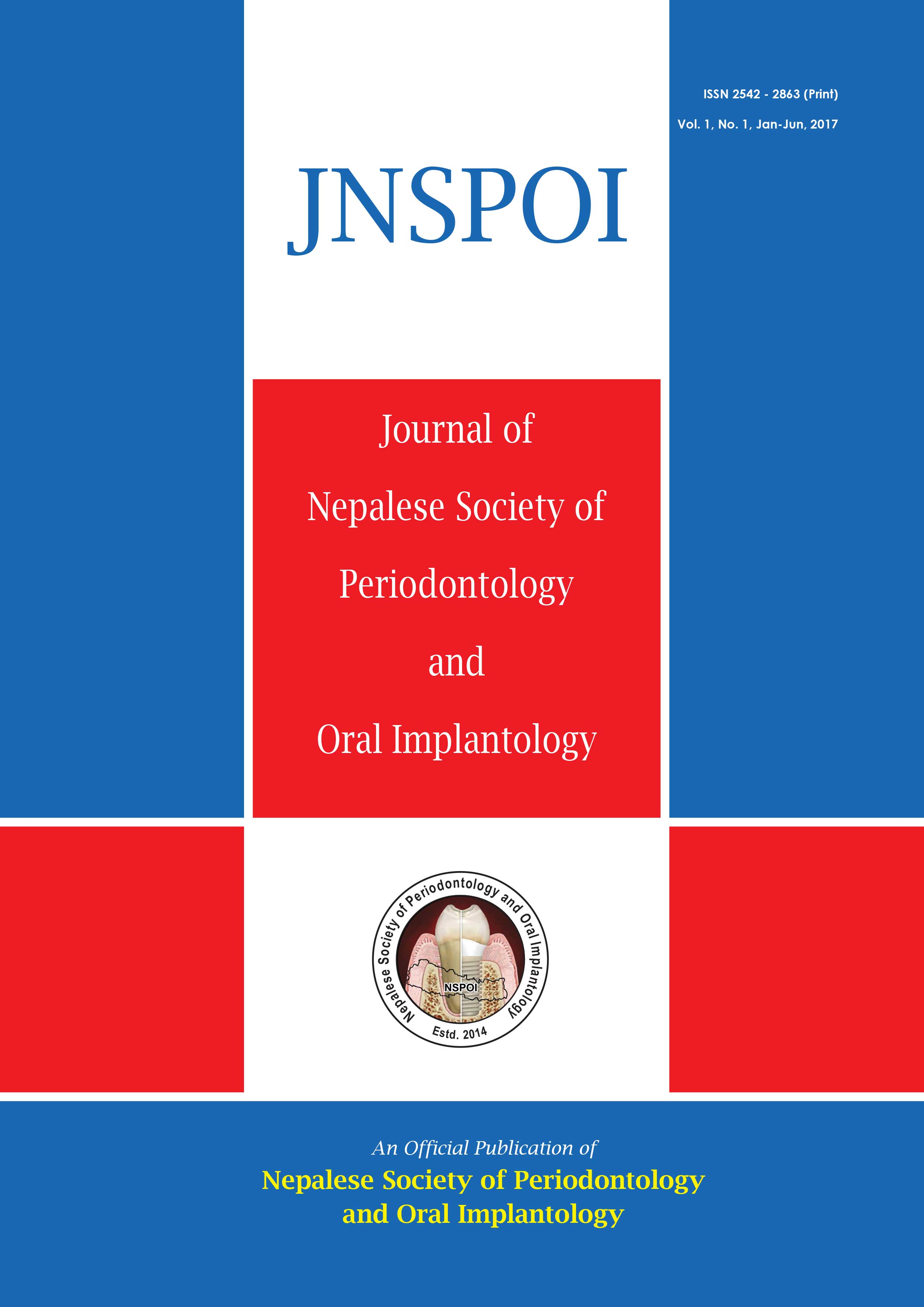Abstract
Background: Biofilm removal is the central part of the etiotropic and maintenance phase of periodontal therapy. Commercially available injection water jets such as Prophy-Jet allows an efficient and convenient biofilm removal as an adjunct to mechanical periodontal therapy. But, due to the abrasive nature of traditionally used air polishing powders such as sodium bicarbonate, there is a continuous research going on for less abrasive materials.
Aims: To compare the effectiveness of air polishing using glycine powder and chlorhexidine acetate powder on tooth surface as compared to ultrasonic scaling and also to evaluate the time taken for stain removal.
Materials and Methods: Thirty fully erupted, single rooted teeth extracted due to poor periodontal prognosis were used in this in-vitro study. The sample teeth were divided into 3 equal groups and stained in coffee solution. The test Groups A and B underwent air-polishing with glycine powder and chlorhexidine acetate powder respectively. Group C was control group and underwent ultrasonic scaling. Time taken for stain removal was recorded. The sample teeth were also evaluated under a stereo-microscope and digital micrometer pre-procedurally and post-procedurally to measure surface changes.
Results: The study showed statistically significant results (p<0.05) when measurements of changes in surface roughness of samples treated with glycine powder air-polishing were compared with ultrasonic scaling and chlorhexidine acetate powder air-polishing were compared with ultrasonic scaling. Surface texture loss as well as time taken for stain removal was minimum with glycine powder and maximum with ultrasonic scaling.
Conclusion: Air-polishing with glycine powder was least abrasive on root surface followed by chlorhexidine acetate powder air-polishing. This is because of the lower particle size of glycine which also covers larger area in lesser time.
Key Words: Chlorhexidine acetate, glycine, maintenance therapy, Prophy-Jet, sodium bicarbonate, stereo-microscope
References
Shick R. Maintenance phase of periodontal therapy. J Periodontol. 1981;52(9):576-83.
Berkstein S, Reliff RL, McKinney JF, Killoy WJ. Supragingival root surface removal during maintenance procedures utilizing an air powder abrasive system or hand scaling an in vitro study. J Periodontol. 1987;58(5):327-30.
Matuliene G, Pjetursson BE, Salvi GE, Schmidlin K, Brägger U, Zwahlen M, Lang NP. Influence of residual pockets on progression of periodontitis and tooth loss: results after 11 years of maintenance. J Clin Periodontol. 2008;35:685–95.
Rosling B, Serino G, Hellstrom MK, Socransky SS, Lindhe J. Longitudinal periodontal tissue alterations during supportive therapy. Findings from subjects with normal and high susceptibility to periodontal disease. J Clin Periodontol. 2001;28:241–9.
Westfelt E. Rationale of mechanical plaque control. J Clin Periodontol. 1996;23:263–7.
Brown LJ, Johns BA, Wall TP. The economics of periodontal diseases. Periodontol 2000. 2002;29:223–34.
Holtfreter B, Schwahn C, Biffar R, Kocher T. Epidemiology of periodontal diseases in the study of health in Pomerania. J Clin Periodontol. 2009;36:14–23.
Micheelis W, Hoffmann T, Holtfreter B, Kocher T, Schroeder E. Epidemiological estimation of the burden of periodontal disease in Germany – attempt of a conclusion. Deutsche Zahnaerztliche Zeitschrift. 2008;63:464–72.
Petersilka G. Subgingival air-polishing in the treatment of periodontal biofilm infections. Periodontol 2000. 2011;55:124–42.
Prophy-Jet and Cavi-Jet, Cavitron Ultrasonic Division of Cooper Care In, Long Island City, New York.
Momber A. Blast cleaning technology. Berlin, Heidelberg: Springer-Verlag Berlin Heidelberg, 2008.
Andreas WM, Kovacevic R. Principle of abrasive water jet machining. 1998.
Barnes CM, Russell CM, Gerbo LR, Wells BR, Barnes DW. Effects of an air-powder polishing system on orthodontically bracketed and banded teeth. Am J Orthod Dentofacial Orthop. 1990;97:74–81.
Castagnola L, Wirz J, Garberoglio R. Die Reinigung der Schmelzoberfla¨ che von Plaque und starken Verfarbungenmitdem Prophy-Jet. Quintessenz. 1983;34:963–72.
Cooley RL, Lubow RM, Patrissi GA. The effect of an air-powder abrasive instrument on composite resin. J Am Dent Assoc. 1986;112: 362–4.
Jost-Brinkmann PG. The influence of air polishers on tooth enamel. An in-vitro study. J Orofac Orthop. 1998;59:1–16.
Petersilka G, Bell M, Mehl A, Hickel R, Flemmig TF. Root defects following air polishing. J Clin Periodontol. 2003;30:165–70.
Petersilka G, Schenck U, Flemmig TF. Powder emission rates of four air polishing devices. J Clin Periodontol. 2002;29:694–8.
Ainamo J, Etemadzadeh H. Prevention of plaque growth with chewing gum containing chlorhexidine acetate. J Clin Periodontol. 1987;14:524-27.
Petersilka G, Bell M, Haberlein I, Mehl A, Hickel R, Flemmig T F. In vitro evaluation of novel low abrasive air-polishing powders. J Clin Periodontol. 2003;30:9–13.
Flemmig, T, Hetzel M, Topoll H, Gerss J, Haeberlein I, Petersilka G. Subgingival debridement efficacy of glycine powder air-polishing. J Periodontol. 2007;78:1002–10.
Vastardis S, Yukna, R, Rice D, Mercante D. Root surface removal and resultant surface texture with diamond-coated ultrasonic inserts: an in vitro and SEM study. J Clin Periodontol. 2005;32:467–73.
Mishkin D, Engler W, Javed T, Darby T, Cobb R, Coffman M. A clinical comparison of the effect on the gingiva of the Prophy-Jet and the rubber cup and paste techniques. J Periodontol. 1986;57:151–4.
Kontturi-Narhi V, Markkanen S, Markkanen H. The gingival effects of dental airpolishing as evaluated by scanning electron microscopy. J Periodontol. 1989;60:19–22.
Orban B, Manella B. A macroscopic and microscopic study of instruments designed for root planing. J Periodontol. 1956;27: 120–34.
Sanderson A. Gingival curettage by hand and ultrasonic instruments. A histologic comparison. J Periodontol. 1956;37:279–90.
Sanderink R, Hirt T. Connective tissue regeneration and reattachment after periodontal therapy. A review of the literature. Schweizer Monatsschrift fur Zahn-medizin. 1984,94:71–85.

